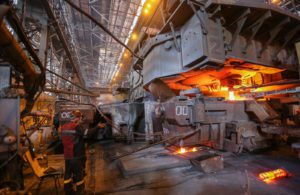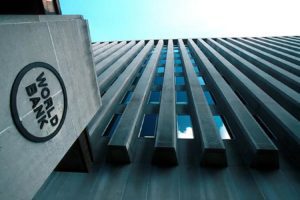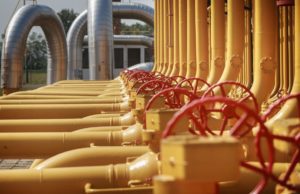
Iron ore mines run by Ukraine’s Metinvest raised output in January-September 2019. An industry source told Interfax that Northern Mining (Pivnichny GOK) produced 6.542 million tonnes of merchant iron ore pellets in the 9M, up 1% year-on-year, including 422,000 tonnes in September; and 9.147 million tonnes of iron or concentrate, up 13.4%, including 923,000 tonnes in September.
Central Mining (Central GOK) raised merchant pellet output 0.1% in 9M 2019 to 1.779 million tonnes and concentrate 1.8% to 3.259 million tonnes, including respectively 209,000 tonnes and 390,000 tonnes in September.
Inhulets Mining (INGOK) reduced concentrate output 0.9% in 9M to 8.351 million tonnes, including 918,000 tonnes in September.
The vertically integrated Metinvest’s main shareholders are System Capital Management (SCM, 71.24%) and Smart Holding (23.76%).

Milk production in Ukraine in January-September 2019 decreased by 3.5% compared to the same period in 2018, to 7.61 million tonnes.
According to the State Statistics Service, in January-September 2019, farmers produced 2.42 million tonnes of meat (live weight), which is 6.4% more than in the same period of 2018.
Egg production grew by 4.3%, to 13.02 billion units.

The World Bank, taking into account the results of H1 2019, has improved its forecast for gross domestic product (GDP) growth in Ukraine in 2019 from 2.7% to 3.4%, expecting that it would accelerate to 3.7% and 4.2% in 2020 and 2021 respectively.
“If the new government is able to deliver on its ambitious reform goals, growth can increase to 4% by 2021,” the World Bank said in its October report entitled “Migration and Brain Drain.”
The analysts said that this will require progress in the following areas: reviving sound bank lending to the enterprise sector by completing the reform of state-owned banks; attracting private investment into tradable sectors by establishing a transparent market for agricultural land, demonopolizing key sectors and strengthening antimonopoly policy and enforcement, privatizing state-owned enterprises, and tackling corruption; and safeguarding macroeconomic stability by addressing current expenditure pressures, securing adequate financing, further reducing inflation, and rebuilding international reserves.
If reforms do not progress and adequate financing is not mobilized, growth could fall below 2% as investor confidence deteriorates, macroeconomic vulnerabilities intensity, and financing difficulties force a compression in domestic demand. Ukraine will need to safeguard macroeconomic stability and manage fiscal risks.
According to the expectations of the World Bank, in 2019, the deficit of the national budget o Ukraine would be 2.2% of GDP. The figure would decrease to 2.1% of GDP in 2020 and to 1.9% of GDP in 2021.
According to the World Bank’s forecast, the public debt will also continue to decline this year to 53% of GDP, but will grow in 2020 and in 2021 to 54.6% of GDP and to 55.3% of GDP, respectively.
As indicated in the materials, the current account deficit will continue to grow: in 2019 – to 3.5% of GDP, in 2020 – to 3.8% of GDP and in 2021 – to 4.3% of GDP.
At the same time, the bank expects a slow increase in net foreign direct investment (FDI) inflows in 2019 and 2020 to 2.2% of GDP and 2.3% of GDP, respectively.
At the same time, inflation will take a downward trend: from 9.5% at the end of last year to 6.8% this year, as well as 6% and 5.4% in 2020 and 2021, respectively.
According to the report of the World Bank’s experts, the main risk for the Ukrainian economy is formidable financing needs. So, according to the analysts, it will take about $11 billion per year, or 8% of GDP, to pay off government debt and finance the budget deficit in the current and next two years.
“To raise the necessary financing, it is critical to maintain the reform momentum and fiscal discipline, while continuing cooperation with development partners,” the bank said in the report.
National bank of Ukraine’s official rates as of 16/10/19

Source: National Bank of Ukraine

Ukraine boosted its natural gas stocks in underground gas storage facilities (UGS) by 23.28 billion cubic meters (bcm), to 21.026 bcm from April 4 to October 13, 2019, according to JSC Ukrtransgaz.
Interfax-Ukraine’s estimates show that this volume exceeds the inventory indicator as of October 13, 2018 by 26.4%, that as of October 13, 2017 by 25.5% and of October 13, 2016 by 42.7%.
Some 594.48 million cubic meters (mcm) was pumped into the country’s storage facilities on October 1 through October 13, which was 45.7 million cubic meters (mcm) per day on the average. The average daily amount in September was 72.5 mcm, it was 77.5 mcm in August, 74.4 mcm in July, 71.9 mcm in June, and 62.9 mcm in May.
Some 44.5 mcm of natural gas was pumped into the country’s UGS facilities on October 13, 2019, alone, while gas import totaled 60.4 mcm and domestic production was 54.9 mcm.
Earlier, Chairman of Executive Board of Naftogaz Ukrainy Andriy Kobolev said that the company planned to pump additional volumes of natural gas into the Ukrainian underground storage facilities in the event that Russia’s Gazprom ceases gas transit through the country in 2020.
As was reported, during the heating season from November 6, 2018, to April 4, 2019, Ukraine’s gas stocks in the UGS facilities shrank by 8.45 bcm (from 17.195 bcm to 8.745 bcm).
Ukrtransgaz, fully owned by Naftogaz Ukrainy, operates a system of gas pipelines and 12 underground gas storages in the country. Their total capacity is 31 bcm.